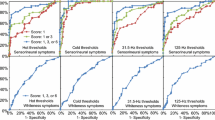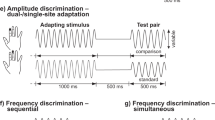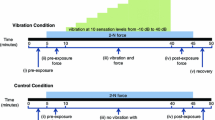Abstract
Objectives
This study was undertaken to compare normal values of thermotactile and vibrotactile thresholds in males and females and in younger and older age groups. In addition, for thermal thresholds, the effects of the contact area (small and large) and stimulus location (glabrous and non-glabrous skin) were investigated.
Method
Eighty healthy subjects participated in the study: 20 males and 20 females aged 20–30 years, and 20 males and 20 females aged 55–65 years. Subjects attended one 45 min experimental session consisting of acclimatisation for 10 min followed by 35 min of testing. Using the method of limits, hot thresholds and cold thresholds were measured on the non-dominant upper limb at three locations (the distal phalanx of the middle finger, the thenar eminence, and the dorsal surface of the forearm) using two circular contactors 1.0 and 2.8 cm in diameter. Using the von Békésy method, vibrotactile thresholds at 31.5 and 125 Hz were measured on the distal phalanx of the middle finger of the non-dominant hand.
Results
Among the younger subjects there were significant gender differences in thermotactile thresholds but not vibrotactile thresholds. Age did not have any significant effect on thermotactile or vibrotactile thresholds. Hot thresholds were significantly higher and cold thresholds significantly lower when the larger stimulus area was used. The thresholds exceeded by 18% of the population (the mean plus one standard deviation) and by 2.5% (the mean plus two standard deviations) are provided and may be used to consider whether measured thresholds are within a “normal” range.
Conclusions
For males and females the same ranges of normal values may be used for vibrotactile thresholds but different ranges of normal values may be required for thermotactile thresholds. An age correction may not be needed for thermotactile or vibrotactile thresholds in persons aged 20–65 years. Contact area has an influence on thermotactile thresholds and should be controlled.



Similar content being viewed by others
References
Bartlett G, Stewart JD, Tamblyn R, Abrahamowicz M (1998) Normal distributions of thermal and vibration sensory thresholds. Muscle Nerve 21(3):367–374
Doeland HJ, Nauta JJP, van Zandbergen JB, van der Eerden HAM, van Diemen NGJ, Bertelsmann FW, Heimans JJ (1989) The relationship of cold and warmth cutaneous sensation to age and gender. Muscle Nerve 12:712–715
Ekenvall L, Nilsson BY, Gustavsson P (1986) Temperature and vibration thresholds in vibration syndrome. Br J Med 43(12):825–829
Gescheider G, Bolanowski SJ, Hall KL, Hoffman KE, Verrillo RT (1994) The effects of aging on information-processing channels in the sense of touch: I. Absolute sensitivity. J Somatosens Mot Res 11(4):345–357
Hardy JD, Oppel TW (1937) Studies in temperature sensation: III. The sensitivity of the body to heat and spatial summation of the end-organ responses. J Clin Invest 16:533–540
Harju E (2002) Cold and warmth perception mapped for age, gender and body area. J Somatosens Mot Res 19(1):61–75
Hilz MJ, Axelrod FB, Hermann K, Haertl U, Duetsch M, Neundörfer B (1998) Normative values of vibratory perception in 530 children, juveniles and adults aged 3–79 years. J Neurol Sci 159(2):219–225
International Organization for Standardization (2001) Mechanical vibration—vibrotactile perception thresholds for the assessment of nerve dysfunction—part 1: Methods of measurement at the fingertips. International Standard, ISO13091-1
Kojo I, Pertovaara A (1987) The effects of stimulus area and adaptation temperature on warm and heat pain thresholds in man. Int J Neurosci 32:875–880
Lindsell CJ, Griffin MJ (2002) Normative data for vascular and neurological tests of the hand–arm vibration syndrome. Int Arch Occup Environ Health, 75(1–2):43–54
Lindsell CJ, Griffin MJ (1998) Standardised diagnostic methods for assessing components of the hand–arm vibration syndrome, HSE Books, CRR197/1998, ISBN 0 7176 1640 1
Liou J-T, Lui P-W, Lo Y-L, Liou L, Wang S-S, Yuan H-B, Chan K-C, Lee T-Y (1999) Normative data of quantitative thermal and vibratory thresholds in normal subjects in Taiwan: gender and age effect. Chin Med J 62(7):431–437
Stevens JC, Marks LE (1971) Spatial summation and the dynamics of the warmth sense. Percept Psychophys 9:391–398
Verrillo RT, Bolanowski SJ, Gescheider GA (2002) Effect of aging on the subjective magnitude of vibration. Somatosens Mot Res 19:238–244
Welsh, AJL, Griffin MJ (2007) Normal values for finger systolic blood pressures in males and females. Int Arch Occup Environ Health. doi:10.1007/s00420-007-0257-1
Wild P, Massin N, Lasfargues G, Baudin V, Unlu D, Donati P (2001) Vibrotactile perception thresholds in four non-exposed populations of working age. J Ergon 44(6):649–657
Acknowledgments
This research was supported by the European Commission under the Quality of Life and Management of Living Resources programme, project no. QLK4-2002-02650 (VIBRISKS).
Author information
Authors and Affiliations
Corresponding author
Additional information
Work presented at the Second International Workshop 2006 on Diagnosis of Hand–Arm Vibration Syndrome in Göteborg, Sweden.
Rights and permissions
About this article
Cite this article
Seah, S.A., Griffin, M.J. Normal values for thermotactile and vibrotactile thresholds in males and females. Int Arch Occup Environ Health 81, 535–543 (2008). https://doi.org/10.1007/s00420-007-0252-6
Received:
Accepted:
Published:
Issue Date:
DOI: https://doi.org/10.1007/s00420-007-0252-6




